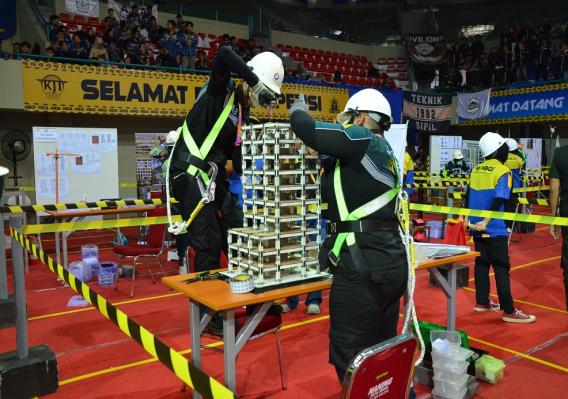UNY Hosts the Indonesia Bridge Competition 2025 and Indonesia Building Structure Competition, Hundreds of Civil Engineering Students Compete at UNY Sports Hall

On Thursday (13–16 November 2025), the Sports Hall of UNY was filled with the enthusiasm of hundreds of civil engineering students from all over Indonesia, participating in the Kompetisi Jembatan Indonesia XX (KJI XX) and the Kompetisi Bangunan Gedung Indonesia XVI (KBGI XVI) held at UNY.
These national competitions, organised by the Kementerian Pendidikan Tinggi Sains dan Teknologi Republik Indonesia (Ministry of Higher Education, Science and Technology of the Republic of Indonesia), serve as a prestigious platform for students to demonstrate innovation, creativity, and structural‐engineering skills oriented towards sustainability.
The participants assembled models of bridges and building structures with great precision, taking into account structural strength, material efficiency, aesthetics, construction safety, and compliance with national technical standards.
The stands of the UNY Sports Hall were filled with mentors, lecturers and supporters who provided full encouragement.
KJI and KBGI are annual national competitions held to develop creativity and capability among civil engineering students in designing and constructing model bridges and buildings.
Given Indonesia’s status as an archipelagic country with more than 17,000 islands, a large population, and geographic challenges such as earthquakes, infrastructure innovation becomes highly important to support mobility, logistics distribution, and sustainable development.
The Minister of Higher Education, Science and Technology, Prof. Brian Yuliarto, praised UNY as the host of these national competitions that encourage the emergence of young innovators in civil engineering and architecture. He remarked: “The major theme of KJI and KBGI emphasises the importance of structural designs that are efficient, environmentally friendly, robust and sustainable as pillars toward Indonesia Emas 2045.”
This activity is not just a competition but a real‐life learning space for civil engineering students to innovate, collaborate, and sharpen their creative and solution‐oriented thinking skills.
Meanwhile, the Director of Student Affairs and Alumni at UNY, Prof. Guntur, affirmed that hosting this national‐level competition aligns with UNY’s commitment to strengthening practice‐based engineering education. “The KJI and KBGI activities are part of the Ministry’s agenda as a venue for student actualisation in civil engineering, and the process to reach this final stage is not easy. Therefore we appreciate this.” said Prof. Guntur on behalf of the Rector.
The competition does not only measure academic abilities but also hones team cooperation, problem solving and awareness of technical issues in the field.
Dr Ir. Faqih Ma’arif, Chair of the KJI & KBGI Committee at UNY, explained the event was attended by 34 teams consisting of: 10 teams in the category of arch‐model bridges, 8 teams in the category of steel‐frame model bridges, 8 teams in steel building structures, and 8 teams in precast concrete building structures.
“The participants this year came from 24 universities across Indonesia with 25 monitoring & evaluation teams, 39 university delegates, 42 team members, 34 supervising lecturers, 34 team leaders, 148 technical teams and 931 supporters, so the total was 1,253 people,” he said.
Over three days, participants went through technical presentations, assembly, and load‐testing of structures — the most tense stage of the competition. Each category required students to understand modern engineering principles that prioritise sustainability, efficiency and safety, in line with the real challenges of infrastructure development in Indonesia — a country with more than 17,000 islands and a risk of geological disasters.
With the holding of KJI XX and KBGI XVI in 2025, UNY affirms its role as a campus that actively supports engineering innovation, applied research, and sustainable infrastructure development in Indonesia. This competition is hoped to produce a generation of young engineers who are adaptive, creative, and ready to contribute to the nation’s future development.






